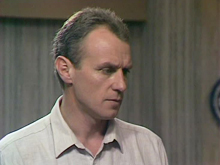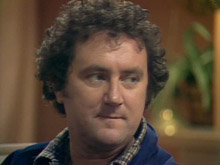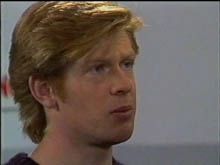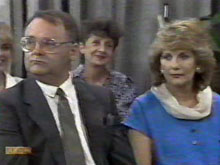|
.
Comment
> The Man Next Door: Part One
by Ryan
They say this is a man’s world – but soap truly would be nothing without a woman or a girl. Soapland is a matriarchy, particularly in Britain. Witness some of the most popular male characters in Coronation Street; Jack Duckworth and, increasingly, Kevin Webster, are henpecked men dominated by bossy wives, while Ken Barlow plays the forgiving husband, taking Deirdre back after more than one incident of infidelity. Over in Eastenders the matriarchal figures of Pat and Peggy largely manage without men altogether; lovers and even husbands are transient figures in their lives.
Neighbours, however, has always been somewhat different. The show currently features not one but two ‘elder statesmen’ in the form of Harold Bishop and Lou Carpenter; while women have come and gone from their lives since the death of Madge, their friendship and strength as individual personalities endures. While UK soaps would struggle without women in the fifty-plus bracket, these women have been conspicuous by their absence on Ramsay Street in recent years. So is Neighbours that rarest of soap breeds – a patriarchy? In the words of Maria Von Trapp, let’s start at the very beginning…
|

|
Back in 1985, men dominated a small cast by a 7:5 ratio. At the centre of the show were two very different and vividly drawn men – the loud, boorish Max Ramsay and the calmer, friendly and approachable Jim Robinson. Max seemed to represent the archetypal ‘brash Aussie bloke’, and for many unfamiliar British viewers, Max actually created that stereotype. Neighbours made its UK debut just as Crocodile Dundee hit the big screens; the contrast of Jim to Max was essential. However, despite their differences, the two men were great friends, probably the first pairing to make the ‘neighbours become good friends’ song lyric ring true. Both were committed fathers, although Max’s tendency to push his kids too hard would often overshadow his genuine love for them. Both also had unconventional relationships with women. While Max’s marriage to Maria appeared fairly traditional, there was an obvious tension between them; something was keeping this beautiful, gentle woman with a husband who didn’t appreciate her, and quite possibly the same thing that was tearing them apart. For widower Jim, meanwhile, the two key women in his life were his daughters – something potential partners such as Anna Rossi and Zoë Davis discovered to their cost. As such, the most enduring female companion in Jim’s life would be his mother-in-law Helen.
Alongside Jim and Max were a trio of twenty-something men, again all close friends, but all bringing something different to the pot. Paul Robinson was something of a ‘live for today’ party boy, impulsively proposing to Terry Inglis on their first date. Shane Ramsay was the happy-go-lucky, everyone’s mate character and, in another Aussie stereotype, a highly promising sportsman. Completing the set was Des Clarke, a hugely likeable (if slightly dopey) trainee bank manager, just starting out on the ladder of life. Jilted just two episodes into Neighbours, Des looked set to be the show’s loser in love – especially when he obviously began to develop feelings for lodger Daphne, who was dating Shane at the time. However, Des did eventually get his girl (albeit after a very long and complicated courtship), proving nice men didn’t have to finish last, and providing a refreshing change.
|

|
For the first year of Neighbours these five men, along with teenagers Scott Robinson and Danny Ramsay, would play a massive role in several key storylines. By contrast, Maria Ramsay and Julie Robinson were gone before the year was out, and Terry Robinson’s exit in a paddy wagon left Helen and Daphne as the only adult women on Ramsay Street as the 1985 finale aired. But 1986 didn’t just mean a change in network for Neighbours; it would bring big changes for the men of the show too…
The big change in the Ramsay household was the arrival of a new female figure. Just as Max and his sons were getting used to their all-male household, the whirlwind that was Madge Mitchell blew into town. Unlike Maria, Madge refused to be browbeaten by brother Max, and as such provided a far better sparring partner for him. This sibling rivalry would not only offer one of the most entertaining relationships on the show, but also opened up and fleshed out Max’s character. Unfortunately a behind the scenes row between actor Francis Bell and the show’s producers brought the partnership to a premature end, and while Max was replaced by older brother Tom, his stay also proved all too short. Nevertheless, Madge’s presence would continue to affect the lives of Ramsay men. While Shane and Danny had been happy to accept Maria’s mothering, they saw Madge as bossy and controlling, and as such became more independent young men.
But perhaps the biggest change of 1986 was in the character of Paul Robinson. Once carefree and happy to live for the day, the change in Paul after being shot by his wife was dramatic. Becoming hardened to the world, money replaced fun in his affections. If Max Ramsay was the typical Aussie grafter, Paul seemed to fit an American stereotype, embodying the ‘greed is good’ yuppie spirit. As if in response to his wife’s attempt at the ultimate de-masculinisation, Paul became almost aggressively male, putting his career before all else. While he spoilt little sister Lucy, and remained especially close to grandmother Helen, other women in Paul’s life were reduced to mere playthings, to be controlled like his company. Despite this change in his character, Paul’s popularity with viewers would only increase as the decade went on.
|

|
1986 also saw the arrival of a new breed of man on Ramsay Street: The Joker. Clive Gibbons was the first character to inhabit this role, making possibly the most original entrance ever when he arrived in a gorilla suit. Clive’s mix of fun and laughter with a genuine sensitivity made him a huge hit with Ramsay Street residents and viewers alike, and when we discovered he was actually a doctor nursing a secret heartache, Clive was given a new dimension. Although he spent just a year on Ramsay Street, Clive opened the door for a whole new breed of Neighbours men, with Henry Mitchell quickly slotting into his place. Like Clive, fun-loving Henry had his sensitive side, despite having spent time in jail, and was an even bigger hit with viewers than his predecessor. What girl wouldn’t love a big brother who worked through the night to pay for her dream wedding dress?
It is worth noting that in a supposedly family-orientated show, there were no married couples at the start of 1986. While Des and Daphne’s wedding midway through the year proved a ratings-grabber, it still left Jim, Paul, Shane and Clive as adult single men. As such, the male characters had an independent quality to them; they were individuals, not husbands. However, as the decade rumbled on, women would play a greater role in the lives of these characters. Paul would remarry, initially for business purposes, but it soon became clear he’d met his match in the strong-minded but soft-hearted Gail. Paul’s father Jim, perhaps even more resolutely single, also finally found a woman who met both his own approval and that of his children in Beverly Marshall. Jim’s marriage brought about a major change in both his character and the viewers’ perception of it. For three years, Jim had been ‘Mr Dad’, and as a single father of four (albeit with strong support from his mother-in-law), he seemed every inch the modern man. Once married to a younger, independent career woman, Jim struggled to adapt and suddenly seemed old-fashioned. Even the family’s youngest male, Scott, was tying the knot, and it seemed fitting that while he remained a schoolboy retaking his exams, his wife was not only working, but as a mechanic. Ironically, just as women began to play a greater role in the lives of the Robinsons, the show’s first married man, Des, found himself a widower after Daphne’s tragic death. Shane, meanwhile, seemed lost after losing out on Daphne, and gradually drifted out of the street that bore his name.
|

|
In the midst of all this change, one man slipped onto Ramsay Street almost unnoticed: Harold Bishop. Brought in as a love interest for Madge (and according to actor Ian Smith, for an original period of just six weeks), Harold might have arrived with a dither rather than a bang, but slowly but surely grew into a hugely popular character. Maybe it was Ian Smith’s chemistry with Anne Charleston, the actress behind Madge. Or maybe it was that there was no one else like Harold on Ramsay Street. Yes, he was pompous; yes, he was a fuddy-duddy. But while Madge was the dominant partner in the relationship, Harold always put up a fight, and never let himself be walked over. His friendships with Jim Robinson and Mrs Mangel gave him an identity as someone other than Madge’s husband, and the arrival of his daughter Kerry offered a further opportunity for character development. Despite all this, few would have predicted at the time the long-term effect Harold would have on Neighbours.
As the eighties drew to a close, the quintet of Jim, Paul, Harold, Des and Henry were joined by a maturing Scott and his best mate Mike Young, with Joe Mangel, another character in the joker mould (although with an initial harder edge) joining them in 1988. With eight strong male figures at the centre of the cast, the role of men seemed secure. However, the end of the decade would bring major changes. 1989 would see three of the most popular male characters depart, as well as a key partnership breaking up. As the nineties began, further changes would alter the position of men in the show forever…
Click here to read part two..
Back |

